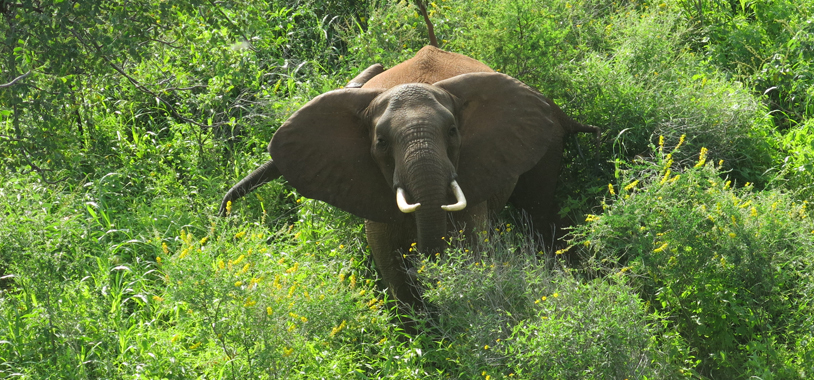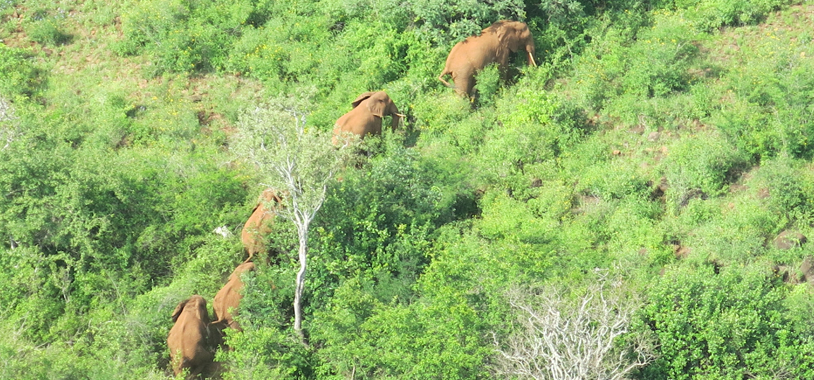Prior to the 2007 deployment of radio collars in Marsabit, STE believed that the elephant population there was completely isolated, despite unconfirmed, local information that there was connectivity between the Marsabit and Samburu populations. After deploying our nine collars, we were able to gain insight into the movements of these elephants. Most of these collars failed sooner than expected due to technical issues, but not before providing us with useful information regarding the elephants’ passage from Marsabit to the Matthews Range and even further East to Bule-marmar Considering the collar failures and the regional poaching between 2009 and 2013, STE together with our close partners NRT has intended to return to Marsabit to replace the collars for some time now.
Following the recent creation of the NRT community conservancies around the mountain in Marsabit, it was deemed a good time to return for collaring. After much logistical planning, the teams departed in two planes on the afternoon of December 10. Ian Craig, accompanied by David, flew one plane and the STE plane piloted by Frank followed close behind. The area was reached before dark and there was still an hour to search for potential targets. Luckily the teams saw quite a few targets that evening, including a group of females, as well as some young males. Since it was getting dark, everyone returned to camp to pitch tents and made a plan for the following day based on the initial scouting.
Very early in the morning, both planes took off. The STE plane searched on the Southwest of the mountain, while Ian’s plane returned to where the elephants had been previously sighted. Ian quickly found a few targets and radioed the STE team. There were no targets found on the Southwest of the mountain, so the STE plane then searched East of the road and found a few additional targets. Everyone then returned to the airstrip to discuss which targets to go for.
The chopper was a bit delayed, as soon as it arrived, the equipment was loaded and the chopper departed in pursuit of the targets. The first target was a lone, middle-aged male. After he was darted, he was still strong and moving, after the usual eight to ten minutes so additional immobilization drugs were used. In the meantime, the male was herded towards the road out of the dense bush, so that the full team could witness the collaring operation. After he finally went down, the collaring operation went smoothly and he was quickly revived. The ground and air teams reunited and decided that the next target would be a female located nearby. After several failed attempts to herd this female into more opened ground the chopper had to leave to refuel. Upon returning, the female was still with her group, but we were fortunate to get an opportunity to dart her. After the usual five to ten minutes she went down, in an area of particularly dense bush, requiring the air team to jump from the chopper to deal with immobilized animal as the chopper took off to lead the others in to the female’s location. The team worked quickly to cut trees down around her, and she too was successfully fitted with a collar. All then departed for a break for the hot sun to cool down before continuing.
At around half past two, both fix wings went out to look for targets. STE plane set off to Bule Marmar north east of the mountain around 100km where elephants are know to be migrating on wet season. As soon as Ian found targets he returned to the base and the darting team took off. A group of ten female elephants was found and the best candidate from the group was selected and immobilized.
As soon as we got the opportunity, we darted her and she went down in a good location and we quickly fitted the collar without the assistance of the ground team. It was getting late, so we knew we could only get one more animal if we are lucky. We found a perfect, lone, middle-aged bull and darted him, but he went down in a bad position on his chest in an area of extremely thick and thorny bush. We decided, given the circumstances, to avoid any risk, revive him, after administering the anti-dart, we remained in the area to make sure he was up on his feet. We then return to camp for the night. Everyone was quite satisfied with the day’s efforts, as three out of five elephants had been collared.
The following morning was an early start again to ensure that the two final collars were deployed. The scout plane, surprisingly, found very few elephants in comparison to the previous day’s scouting. However, two targets were located relatively early in the day, allowing the scouting team to return and the darting team to take off in the chopper. Since the female target was not in an ideal area, given the thickness of the bush, we decided to go after her first. Luckily she was quickly separated from her group and went down just five minutes after darting. As soon as we finished, we called in the ground team, since the second target, a bull, was very close to the road. We darted him as soon as we could and herded him towards the road to involve the full team in this final operation. The bull continued to move away from the approaching chopper and after 15 minutes, a second dart was prepared and administered by the vet on foot. The ground and air teams approached the bull with caution and had to roll him onto his side once he was definitively out. During the collaring, we realized that he was presently in musth, which could explain why he did not initially respond to the immobilization drug.
The most significant findings from this collaring operation concern the unexpectedly small population of elephants found in the area. The 2009 to 2013 poaching must have hit this population very hard; many teenaged elephants were seen without any adults present, meaning that the age structure in the population was very altered. We also observed that there were very few young calves in the herds that were seen. It will be very interesting to see the data that these five collars produce, especially regarding the elephants’ movements and whether they still use their historical migration routes to the South and East. There is a sense of hope for further protection for the valuable natural resources in this northern region now with the three newly formed community conservancies offering support for KWS’ efforts from a local level.



